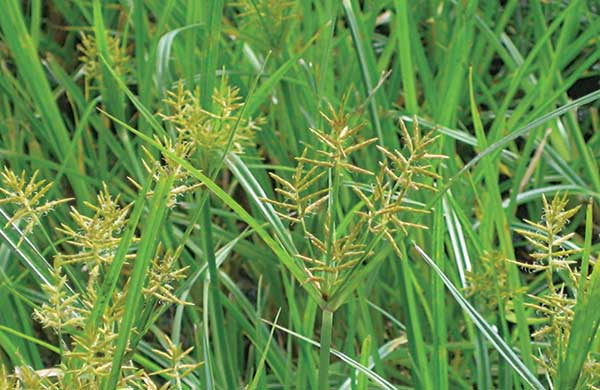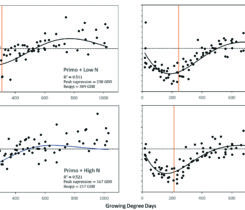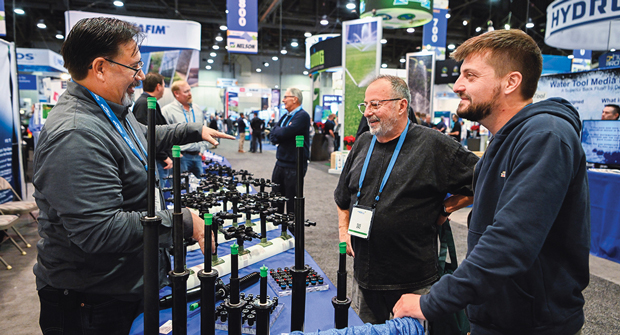Experts’ Insights: Know your sedge

Yellow nutsedge can often be easier to manage than its counterpart, purple nutsedge. (Photo: Jim Brosnan, Ph.D., University of Tennessee)
When it comes to sedge management, proper identification is critical, says Jim Brosnan, Ph.D., professor in the Plant Sciences Department at the University of Tennessee. He says a good example of why proper ID is important is because purple nutsedge is more of a challenge to manage than yellow nutsedge.
“There’s an ID piece there that can be tricky if you don’t have a fully developed plant, one that’s being mowed regularly, so the floral component of that plant might not be there,” he says.
Brosnan says kyllinga is another member of the sedge family that’s easy for superintendents to misdiagnose or miss as it has a similar leaf texture and growth to some turfgrass species. This can be an issue in northern states, since kyllinga (once thought to be a southern weed) has been found as far north as Connecticut.
“That’s a point where superintendents might be caught off guard, thinking ‘that’s a southern weed,’ and it’s moving north pretty readily,” he says. “It’s one to keep an eye out for.”
To ensure you have proper weed ID, Brosnan encourages superintendents to take advantage of the Extension services of their land grant university. He says there are also great resources online through NC State, UT and the University of Missouri, among others.
Sedges are good indicators of wet spots on a course, and Brosnan recommends taking a look at the underlying cause of wet spots in order to manage sedges with an integrated approach.
“If I just spray that herbicide, I’m probably going to have kyllinga problems in the future because I haven’t changed the growing environment,” he says, noting that a better approach is to use an herbicide to control the weed growth, in addition to addressing any drainage issues that may be causing wet spots.

Dean Mosdell (Photo: Syngenta)
Syngenta
Dean Mosdell, Ph.D.
Technical services manager
Sedges can be found on a variety of turf types. Purple nutsedge is not cold tolerant, so it proliferates in southern climates. At least one species of kyllinga can be found in most U.S. states except for those in more northern climates. Yellow nutsedge can be found in most U.S. states but is less common in the Deep South and Hawaii.
Improve drainage and turf competition. Don’t move soil that is contaminated. These weeds are perennial C4 plants, so postemergent herbicides are ideal options. Although acetamide herbicides have activity on germinating tubers of yellow nutsedge, turf tolerance is limited to warm-season grasses. On warm-season grasses, ALS inhibitors are effective on sedges and kyllinga. On cool-season turf, mesotrione is effective at seeding, and herbicides containing halosulfuron or sulfentrazone are options in most established turf species.

Todd Lowe (Photo: Bayer)
Bayer
Todd Lowe
Technical services manager
There are many sedges that are problems in turf, and each have glossy three-ranked leaf arrangements and triangular stems. However, kyllingas have a single spike seedhead, while yellow nutsedge has a seedhead with stalked clusters of yellowish seeds, and purple nutsedge has purplish seeds. Yellow and purple nutsedge also have underground tubers. Sedges favor moist soils, so improving soil drainage and reducing soil saturation, to the extent possible, can help discourage sedges. Recent research from the University of Nebraska shows the most effective controls are thick turf and postemergence applications in the three-to-five leaf stage (earlier than previously thought). A dedicated postemergence program is needed, and with most sedges and kyllingas, repeat applications are required for perennial sedges and kyllingas.

Tina Bond (Photo: FMC Professional Solutions)
FMC Professional Solutions
Tina Bond, Ph.D.
Technical service manager
Sedges can be found throughout the golf course. Sedges have a triangular stem and leaves arranged in threes. Nutsedge grows sparsely. Yellow nutsedge produces yellow flowers and tubers at the tip of the rhizome. Purple nutsedge produces purple flowers and hairy tubers connected by rhizomes. Kyllinga grows in thick mats, produces a round seedhead and spreads via rhizomes. Yellow nutsedge and kyllinga are distributed across the U.S. Purple nutsedge is found in warm-season climates across the Southern U.S. Manage turfgrass so it will outcompete weeds, and properly manage drainage and irrigation to prevent infestations. Do not plant infested sod or tuber-contaminated soil. Sulfentrazone can be used to manage sedges. Time applications after shoot emergence but before tuber production.

Eric Reasor (Photo: PBI-Gordon)
PBI-Gordon Corp.
Eric Reasor, Ph.D.
Southeast research scientist
Nutsedges and kyllinga are in the Cyperaceae plant family, making them difficult to identify. They have a triangular-shaped stem and glossy appearance. Purple nutsedge leaves are abruptly pointed, and yellow nutsedge slowly tapers to a point. Kyllinga typically has a finer leaf texture than nutsedges and a light green color.
Nutsedges and kyllinga can occur on any part of the golf course; however, kyllinga is more common on greens. Purple nutsedge is more common than yellow in southern regions, whereas kyllinga is moving farther north. Cultural control measures may not provide acceptable control. Fortunately, there are several herbicide active ingredients. Some active ingredients include sulfentrazone, halosulfuron, flazasulfuron, trifloxysulfuron, imazosulfuron and pyrimisulfan. Be sure to read the herbicide label prior to any application.












